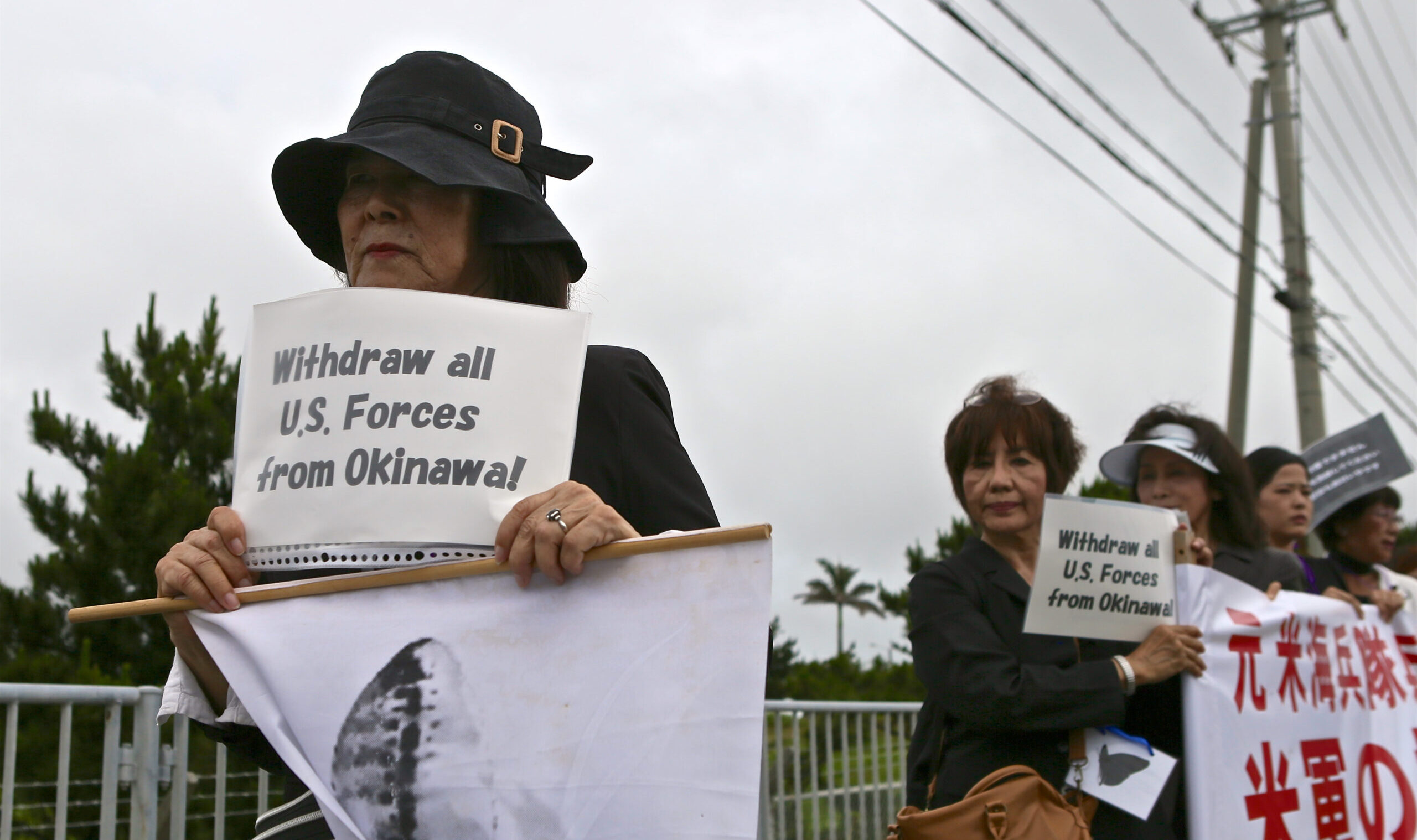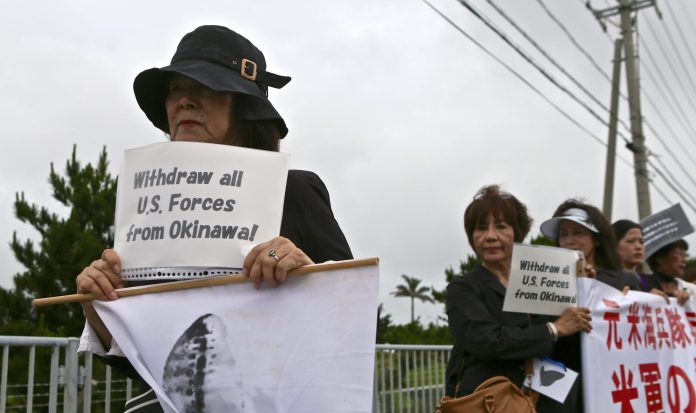
When I last visited Okinawa, protesters daily gathered outside of the gates of Camp Schwab, one of America’s many military installations on the Japanese island of Okinawa. The site of one of the Second World War’s most horrific battles, Okinawa was occupied for decades by the American military, which loaded the territory with military bases.
Today a fifth of Okinawa’s main island remains in US hands, to the frustration of most residents. Just 0.6 percent of Japan’s land mass hosts 70 percent of American military forces in the country. As a sop to locals Washington is supposed to relocate the U.S. Marine Corps Air Station Futenma to the coastal territory in Henoko. The project, however, is now more than a decade behind schedule and won’t be completed until sometime in the 2030s. Moreover, reported journalist Thisanka Siripala,
Okinawans are overwhelmingly against the replacement plan, saying their prefecture already carries too heavy a burden in terms of hosting U.S. bases. They want the Futenma replacement facility either moved to another prefecture within Japan or scrapped altogether. Successive governors of Okinawa prefecture have sought to delay construction through legal wrangling, including revoking permits for necessary work and questioning the environmental impact. Japan’s central government, however, remains committed to the current plan, seeing it as crucial for the overall Japan-U.S. alliance.
Unfortunately, Okinawa’s problem runs far deeper than the location of just one base.
As the Second World War rushed to its bloody conclusion, the U.S. seized the island from Imperial Japan. Hundreds of thousands—American and Japanese soldiers and Okinawan civilians—died in the nearly three months of fighting. The main island is dotted with memorials, such as the Peace Memorial Park, where the Japanese army headquarters was located and the final battle occurred, and the Cornerstone of Peace memorial, where victims’ names are inscribed on 116 wide granite pedestals.
Japan regained its sovereignty in 1952, but the island remained under American occupation. Washington seized private land, interned residents, suppressed public protests, and militarized the island. Base construction utilized “bayonets and bulldozers,” that is, expelling the land-owners and reworking their property. Washington’s excuse was the Cold War.
Although the island was returned in 1972, the U.S. military continues to intrude in island life. Prime real estate and beautiful beaches still are controlled by the Pentagon. Neighborhoods abut bases. Long fences keep Okinawans out of territory once part of their community. The presence of thousands of foreign young men creates social friction, including high-profile crimes. Three cases of alleged sexual assault this past summer caused Okinawa’s Governor Denny Tamaki to complain about the U.S. military’s lack of transparency.
Alas, Okinawans’ protests have achieved little because Tokyo as well as Washington benefits from the current system. The U.S. wants military facilities in the region, especially in a country which provides significant “host nation support,” but emphasizes that Japan makes the final decision. Tokyo desires a military presence atop America’s underlying security guarantee and points to Washington’s requirements. This perfect circle freezes out the Okinawan people.
Tamaki explained, “Even 50 years after Okinawa’s return to Japan, the prefecture is still being forced to bear the excessive burdens of military bases, including accidents, crimes and the problems of noise and environmental pollution.” By denying Okinawans use of their own land and resources, the U.S. presence, though bringing in U.S. money, has been estimated to divert far more from the island, as much as $8 billion annually, though the number has been declining of late.
Of course, many nations host American military facilities, and not always happily. But their landscapes are not covered in bases. The U.S. presence is magnified on an island, since it is impossible to simply move down the road another mile or two. Moreover, noted the prefectural government, “most of the U.S. military bases on Okinawa are concentrated in flat and highly useful lands in the urban area of the Central and Southern part of” the main island, which holds 80 percent of the population. Overall, editorialized the New York Times: “The concentration of military gear and troops has created noise, pollution, deadly accidents and a history of assaults.”
In 2013 a new think tank, the New Diplomacy Initiative, formed, and published a blueprint for ameliorating the burden on Okinawans while maintaining the US-Japan defense relationship. Alas, NDI found little interest for its ideas in Washington. After his election in 2018, Tamaki, who never met his U.S. Marine father, visited America’s capital to lobby the Trump administration. He explained, “I want the American people to understand what has been, what is and what will be, to solve this problem.” Again nothing changed.
Today U.S. bases put the Okinawan people in great danger if the United States and China end up at war—most likely over Taiwan, or one of several maritime and territorial disputes. Noted Yoko Shima, editor of the Ryukyu Shimpo, which has backed closure of the American facilities, “There is a high possibility that Okinawa will become a target, because there are currently U.S. military bases here. So, it shouldn’t become a target.” The Okinawan people agree. While 70 percent of them believe that they bear an “unfair” burden of US bases, an incredible 83 percent believe that “military bases in Okinawa Prefecture would be targets of an attack in an emergency.”
The Okinawan people have not chosen to take this risk. America’s oversize military presence did not arise out of the free choice of the Okinawan or even Japanese people. Rather, Washington turned the island into a major military hub while occupying the province. Even after the US returned political authority to Japan, the latter remained in a subordinate position, reluctant to challenge its protector.
Okinawan frustration peaked after the 1995 rape of a schoolgirl. The commander of U.S. Pacific Command, Admiral Richard C. Macke, compounded the outrage when he publicly wondered why the three men had not simply hired a prostitute. The incident set off mass demonstrations (and forced his retirement). Yet the bases remain. Washington and Tokyo have done as little as possible while seeking to placate the population.
First was an emphasis on better PR. In 2012 the CIA suggested that the Pentagon emphasize economic benefits, cultural exchange, and disaster relief. The agency dismissed arguments based on deterrence: “Okinawans may react with frustration to messages about the deterrence value of U.S. forces because that does not answer their ‘why us’ question.” Moreover, the CIA urged no mention of the environment, which “presents challenges to alliance managers” since there obviously is no pro-environment argument to be made. Matthew Reisener of the Center for the National Interest similarly advocated improved “community relations by exploring opportunities for expanding [America’s] popular educational outreach programs.”
Second was lightening the community burden by moving Futenma Air Station. The objective, according to US officials, was to make America’s military presence “more geographically distributed, operationally resilient, and politically sustainable.” However, the Futenma to Henoko palliative failed to satisfy Okinawans. Complained Tamaki, Tokyo officials “say Henoko is the only [option], Henoko is the only solution. But we think that it is definitely not the case and that they’re refusing to think critically.” Popular protests continue. Demonstrators with whom I spoke offered a range of reasons for opposing the base move, including environmental threats, military burdens, and anger at the “bullying” of their island.
Only once has Tokyo seemed genuinely sympathetic to the plight of the Okinawans. Prime Minister Yukio Hatoyama led the Democratic Party of Japan to victory over the Liberal Democrats in 2009 and committed to relieving the burden on Okinawans. The Obama administration launched a brutal political offensive against the Hatoyama government, causing the premier to reluctantly abandon his promise and resign after less than a year in office. His successor, Naoto Kan, returned to a policy of supine submission to Washington, which continues today, and endorsed the Futenma relocation.
Although the island has been called the “Keystone of the Pacific,” its value is more assumed than demonstrated. “The United States must remain in Okinawa despite local opposition,” Reisener insisted. “American military installations on the island prefecture are essential to ensuring both American and Japanese interests in the critically important region of East Asia.” However, though the Marine Expeditionary Force packs impressive firepower, it has little practical role in the region. It is not necessary for Japan’s defense. If Tokyo believes it needs a few thousand more ground forces, it could raise them. Similar is the MEF’s potential value in any war on the Korean Peninsula, where South Korea could expand its own military if necessary. The U.S. has no security interests at stake which warrant deploying the MEF in Southeast Asia.
Subscribe Today
Get daily emails in your inbox
Finally, if the U.S. and China end up battling over, say, Taiwan or the Senkaku/Diaoyu Islands, combat will not be on the ground. Nearly three decades ago, Mike Mochizuki, a professor at the George Washington University and former Brookings Institution scholar, and Michael E. O’Hanlon, of the Brookings Institution, observed that “Marines are simply not the right instrument of military force for addressing possible Chinese threats to the Spratly Islands, Taiwan, or the sea lanes of the South China Sea.”
As for issues of international credibility, Japan could do more for the region as well as itself. Some analysts contend that host nation support makes it cheaper for the U.S. to maintain troops overseas, but the most important cost is raising the forces. Commitments require force structure. Washington should be shedding, not just sharing, its allies’ defense burdens. Fear of China and North Korea have spurred Japanese military efforts in recent years, but Tokyo could do even more in response to an American drawdown. Tokyo also would be free to decide that it would be better to stay out of a U.S.–China fight, that the risks would be greater than any rewards of war.
Even if Washington and Tokyo decided to maintain an American military presence, the burden should be spread more evenly throughout Japan. That objective alone warrants closing some facilities on and shifting others from Okinawa. Although the primary responsibility for doing so lies with Tokyo, Washington was responsible for the prefecture’s initial burden and is complicit in the continuing unfairness. It is well past time for the U.S. to leaven security concerns with justice and fairness, which requires listening to those who live with the bases.


